Electrochemical Hydrogen Production Powered by PV/CSP Hybrid Power Plants: A Modelling Approach for Cost Optimal System Design
Abstract
:1. Introduction
2. PV/CSP Hybrid Hydrogen Plant Design Optimization Model
2.1. Concept Solar Hydrogen Production Plant
2.2. Optimization Approach
2.3. Approach Modelling
2.3.1. AEL Electrolyser System and Hydrogen Production
2.3.2. PV System Electricity Output
2.3.3. CSP System Thermal Power Output
- CSP system receiver concentrated power input:
- Molten salt receiver thermal power output:
2.3.4. CSP Part and Steam Cycle Auxiliary Electric Consumption
2.3.5. Power Cycle Electricity Production
2.3.6. Energy Balance Thermal Heat Storage
2.4. Operational Strategy of the PV/CSP Hybrid Hydrogen Production Plant
2.4.1. Operational Strategy for AEL System Electricity Provision
2.4.2. Operational Strategy Electricity Provision of PV/CSP
2.5. Model Validation
3. Techno-Economic Assumptions and Equipment Costs
3.1. General Techno-Economic Assumptions
3.2. Product Cost Calculation Method
3.3. Net Present Value of Hydrogen Production Plant
3.4. Investment and Operational Cost Assumptions
3.4.1. AEL System
3.4.2. PV System and Electric Heater
3.4.3. CSP, TES and Power Block
4. Simulation Results and Discussion
4.1. Optimal PV, CSP/AEL System Combinations
4.1.1. PV-AEL Hydrogen Plant Results
4.1.2. PV/CSP-Hybrid-AEL Plant and Overall LCOH Results
4.1.3. PV/CSP-Hybrid-AEL Plants Suggested Plant Design
4.2. Economic Interpretation of the Results
5. Conclusions and Outlook
Author Contributions
Funding
Acknowledgments
Conflicts of Interest
Nomenclature
| Abbreviations | Greek Letters | ||
| AoI | annuity of investment | energetic efficiency | |
| AEL | alkaline electrolyser | Technical Nomenclature | |
| CAPEX | capital expenditure | area (m2) | |
| CSP | concentrated solar power | specific cost of water (USD/kgH2) | |
| CRF | capital recovery factor | cost of additional electricity | |
| DNI | direct normal irradiance | internal interest rate | |
| EPC | total major equipment costs | power (J/s) | |
| FLH | full load hours | thermal energy (J) | |
| GHI | global horizontal irradiance | rate of heat transfer (J/s) | |
| LCOE | levelized cost of electricity | Subscripts | |
| LCOH | levelized cost of hydrogen | add | additional |
| LCOS | Levelized cost of storage | aux | auxiliary |
| LHV | lower heating value | av | available |
| OMC | operating and maintenance costs | el | electric |
| PV | photovoltaics | H2 | hydrogen |
| TEA | techno-economic analysis | in | input stream |
| TES | thermal energy storage | Sys | system |
| TIC | total installed cost | ||
| TRR | total revenue requirement | ||
| USD | US Dollar | ||
| WNP | net present worth | ||
References
- European Commission. The European Green Deal COM/2019/640 Final; European Commission: Brussels, Belgium, 2019. [Google Scholar]
- FCH JU. Hydrogen Roadmap Europe. A Sustainable Pathway for the European Energy Transition, 1st ed.; FCH JU: Luxembourg, 2019. [Google Scholar] [CrossRef]
- The National Hydrogen Strategy; Federal Ministry for Economic Affairs and Energy, P.R. Division: Berlin, Germany, 2020.
- Ram, M.; Galimova, T.; Bogdanov, D.; Fasihi, M.; Gulagi, A.; Breyer, C.; Micheli, M.; Crone, K. Powerfuels in a Renewable Energy World -Global Volumes, Costs, and Trading 2030 to 2050; LUT University and Deutsche Energie-Agentur GmbH (dena): Lappeenranta, Finland; Berlin, Germany, 2020; ISBN 978-952-335-551-4. [Google Scholar]
- Trieb, F.; Schilling, C.; O’Sullivan, M.; Pregger, T.; Hoyer-Klick, C. Global potential of concentrating solar power. In Proceedings of the SolarPaces Conference, Berlin, Germany, 15–18 September 2009. [Google Scholar]
- Buttler, A.; Spliethoff, H. Current status of water electrolysis for energy storage, grid balancing and sector coupling via power-to-gas and power-to-liquids: A review. Renew. Sustain. Energy Rev. 2018, 82, 2440–2454. [Google Scholar] [CrossRef]
- IEA. Hydrogen Projects Database; IEA: Paris, France, 2020; Available online: https://www.iea.org/reports/hydrogen-projects-database (accessed on 12 April 2020).
- Steeb, H.; Abaoud, H. HYSOLAR: German-Saudi Joint Program. on Solar Hydrogen Production and Utilization. Phase II, 1992–1995; DLR Stuttgart: Stuttgart, Germany, 1996. [Google Scholar]
- Godula-Jopek, A.; Stolten, D. Hydrogen Production: By Electrolysis, 1st ed.; John Wiley & Sons, Incorporated: Berlin, Germany, 2015. [Google Scholar]
- Smolinka, T.; Wiebke, N.; Sterchele, P.; Lehner, F.; Jansen, M. Studie IndWEDe Industrialisierung der Wasser elektrolyse in Deutschland: Chancen und Herausforderungen für nachhaltigen Wasserstoff für Verkehr, Strom und Wärme; Nationale Organisation Wasserstoff-und Brennstoffzellentechnologie–NOW GmbH: Berlin, Germany, 2018. [Google Scholar]
- Ursúa, A.; Barrios, E.L.; Pascual, J.; Martín, I.S.; Sanchis, P. Integration of commercial alkaline water electrolysers with renewable energies: Limitations and improvements. Int. J. Hydrogen Energy 2016, 41, 12852–12861. [Google Scholar] [CrossRef]
- Buck, R.; Schwarzbözl, P. Comprehensive Energy Systems; Elsevier BV: Amsterdam, The Netherlands, 2018; pp. 692–732. [Google Scholar]
- Pitz-Paal, R. Concentrating solar power. In Future Energy, 3rd ed.; Letcher, T.M., Ed.; Elsevier Science: Amsterdam, The Netherlands, 2020; pp. 413–430. [Google Scholar]
- Boisgibault, L.; Al Kabbani, F. Energy Transition in Metropolises. In Energy Transition in Metropolises, Rural Areas and Deserts; ISTE Ltd and John Wiley & Sons, Inc.: Hoboken, NJ, USA, 2020; pp. 17–108. [Google Scholar] [CrossRef]
- Moris, C.H.; Guevara, M.C.; Salmon, A.; Lorca, Á. Comparison between concentrated solar power and gas-based generation in terms of economic and flexibility-related aspects in Chile. Energies 2021, 14, 1063. [Google Scholar] [CrossRef]
- Roeb, M.; Brendelberger, S.; Rosenstiel, A.; Agrafiotis, C.; Monnerie, N.; Budama, V.; Jacobs, N. Wasserstoff als ein Fundament der Energiewende Teil 1: Technologien und Perspektiven für eine Nachhaltige und Ökonomische Wasserstoffversorgung; Deutsches Zentrum für Luft- und Raumfahrt e. V. (DLR): Köln, Germany, 2020. [Google Scholar]
- Gallardo, F.I.; Ferrario, A.M.; Lamagna, M.; Bocci, E.; Garcia, D.A.; Baeza-Jeria, T.E. A techno-economic analysis of solar hydrogen production by electrolysis in the north of Chile and the case of exportation from Atacama Desert to Japan. Int. J. Hydrogen Energy 2020, 46, 13709–13728. [Google Scholar] [CrossRef]
- Dersch, J.; Dieckmann, S.; Hennecke, K.; Pitz-Paal, R.; Taylor, M.; Ralon, P. LCOE reduction potential of parabolic trough and solar tower technology in G20 countries until 2030. AIP Conf. Proc. 2020, 2303, 120002. [Google Scholar] [CrossRef]
- OECD. Price Level Indices (Indicator). 2018. Available online: https://data.oecd.org/price/price-level-indices.htm (accessed on 28 May 2018).
- MathWorks. Global Optimization Toolbox User’s Guide; The MathWorks, Inc.: Natick, MA, USA, 2021. [Google Scholar]
- Dersch, J. Techno-economic evaluation of renewable energy projects using the software greenius. Int. J. Therm. Environ. Eng. 2015, 10, 17–24. [Google Scholar]
- Dersch, J. Greenius—The Green Energy System Analysis Tool; Deutsches Zentrum für Luft- und Raumfahrt, Institute of Solar Research: Cologne, Germany, 2018. [Google Scholar]
- Schmidt, O.; Melchior, S.; Hawkes, A.; Staffell, I. Projecting the future levelized cost of electricity storage technologies. Joule 2019, 3, 81–100. [Google Scholar] [CrossRef] [Green Version]
- Schmidt, O. Lifetime Cost of Electricity Storage. 2019. Available online: https://energystorage.shinyapps.io/LCOSApp/ (accessed on 24 April 2020).
- Bejan, A.; Tsatsaronis, G.; Moran, M. Thermal Design and Optimization; Wiley: New York, NY, USA, 1996. [Google Scholar]
- Pintarič, Z.N.; Kravanja, Z. Selection of the economic objective function for the optimization of process flow sheets. Ind. Eng. Chem. Res. 2006, 45, 4222–4232. [Google Scholar] [CrossRef]
- Van ’t Noordende, H.; Ripson, P. Baseline Design and Total Installed Costs of a GW Green Hydrogen Plant. State-of-the-Art Design and Total Installed Capital Costs; Institute for Sustainable Process Technology (ISPT): Amersfoort, The Netherlands, 2020; Available online: https://ispt.eu/projects/hydrohub-gigawatt/ (accessed on 12 April 2020).
- IRENA. Renewable Power Generation Costs in 2019; International Renewable Energy Agency: Abu Dhabi, United Arab Emirates, 2020. [Google Scholar]
- IRENA. Future of Solar Photovoltaic: Deployment, Investment, Technology, Grid Integration and Socio-Economic Aspects (A Global Energy Transformation: Paper); International Renewable Energy Agency: Abu Dhabi, United Arab Emirates, 2019. [Google Scholar]
- Schöniger, F.; Thonig, R.; Resch, G.; Lilliestam, J. Making the sunshine at night: Comparing the cost of dispatchable concentrating solar power and photovoltaics with storage. Energy Sources Part B Econ. Plan. Policy 2021, 16, 55–74. [Google Scholar] [CrossRef]
- De Vita, A.; Kielichowska, I.; Mandatowa, P.; Capros, P.; Dimopoulou, E.; Evangelopoulou, S.; Dekelver, G. Technology Pathways in Decarbonisation Scenarios; Tractebel, Ecofys, E3-Modelling: Brussels, Belgium, 2018. [Google Scholar]
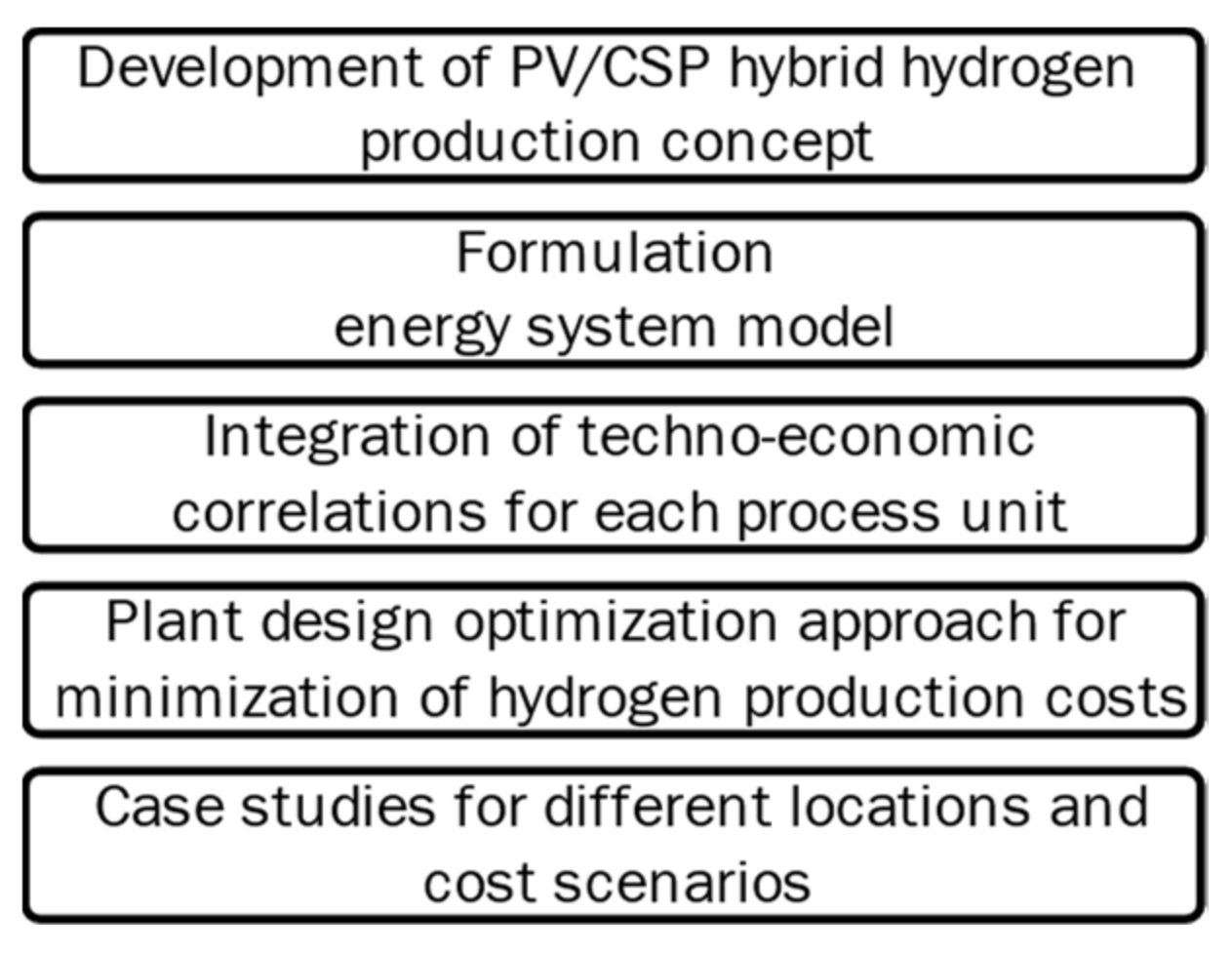
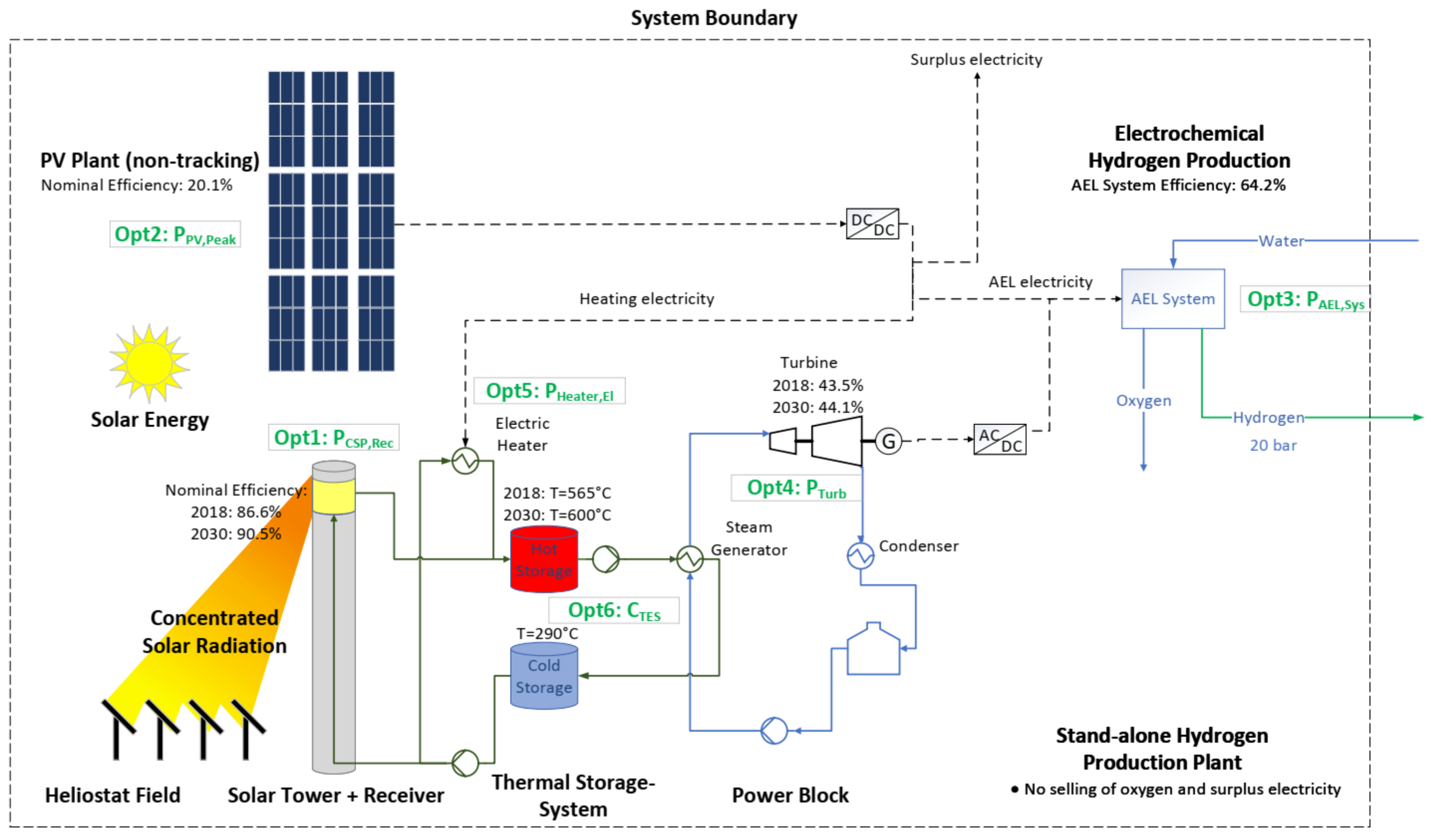

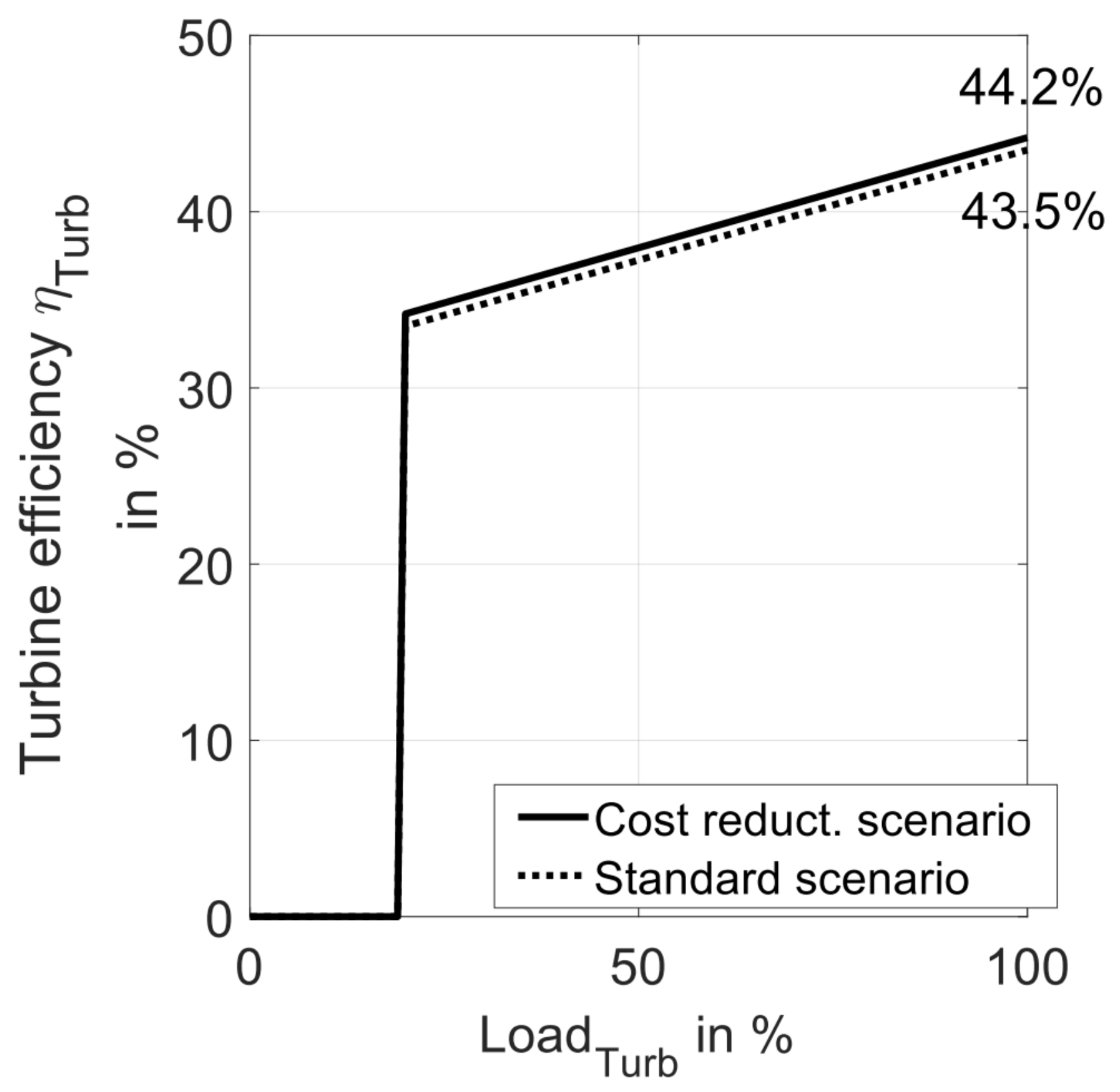
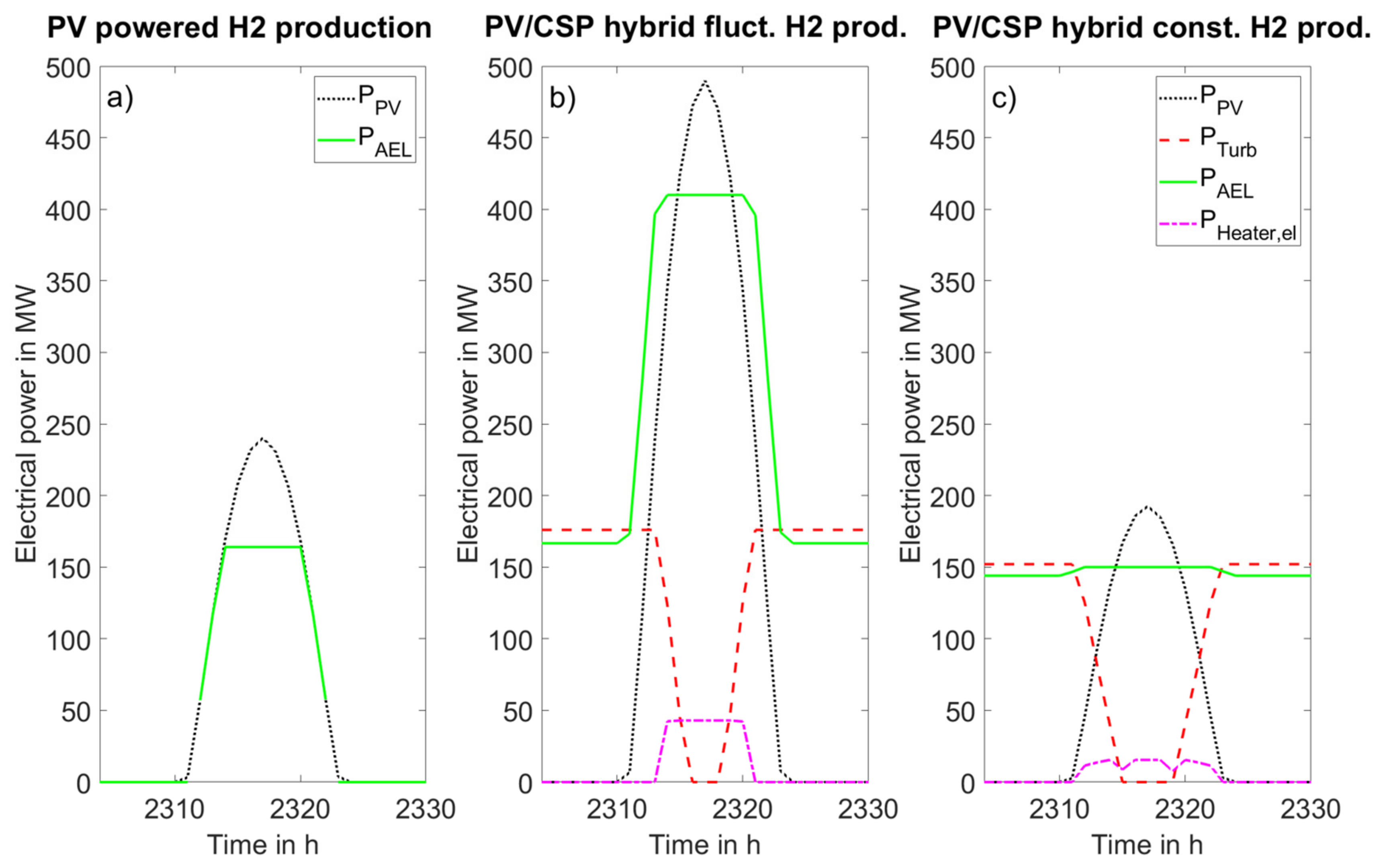

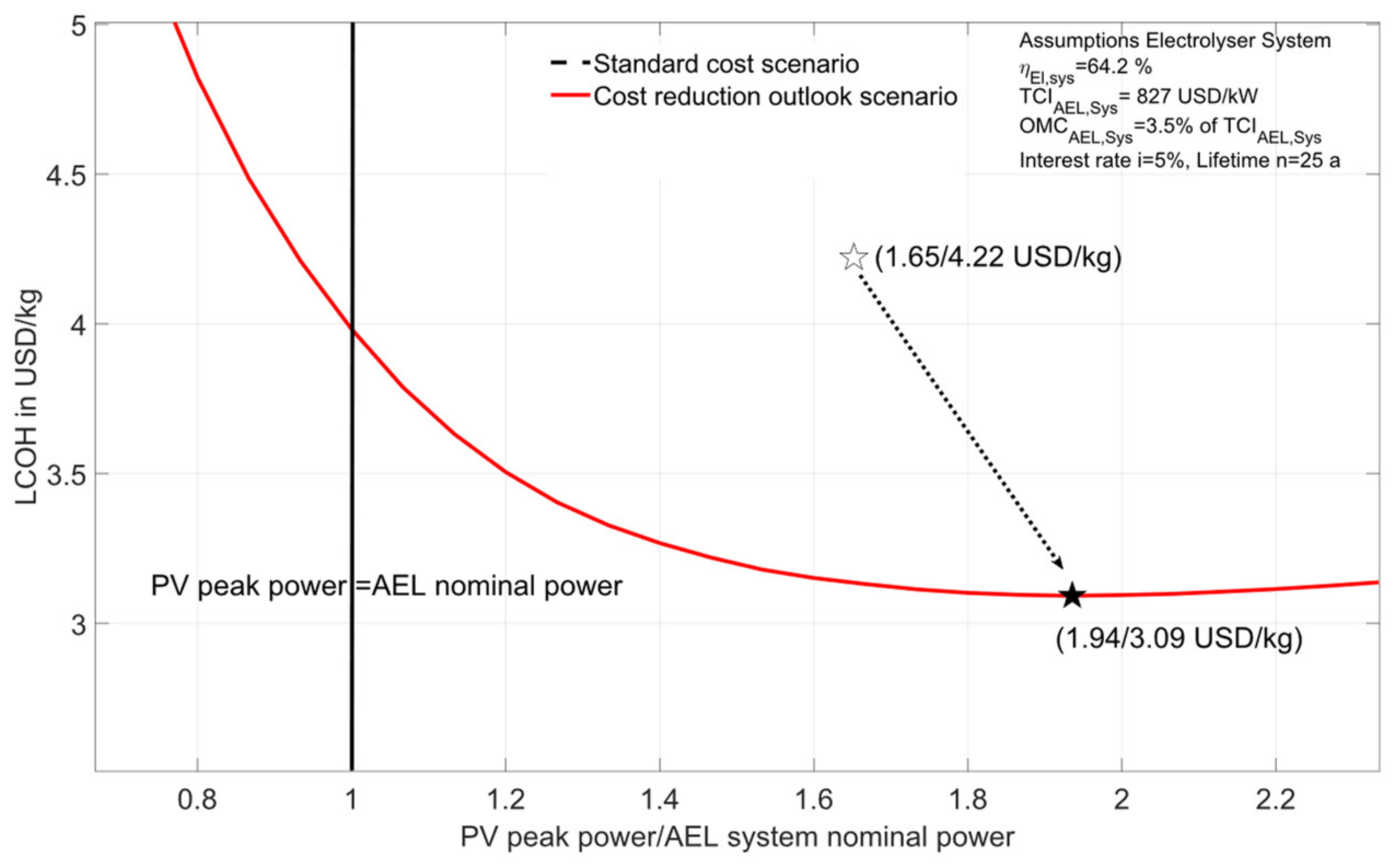
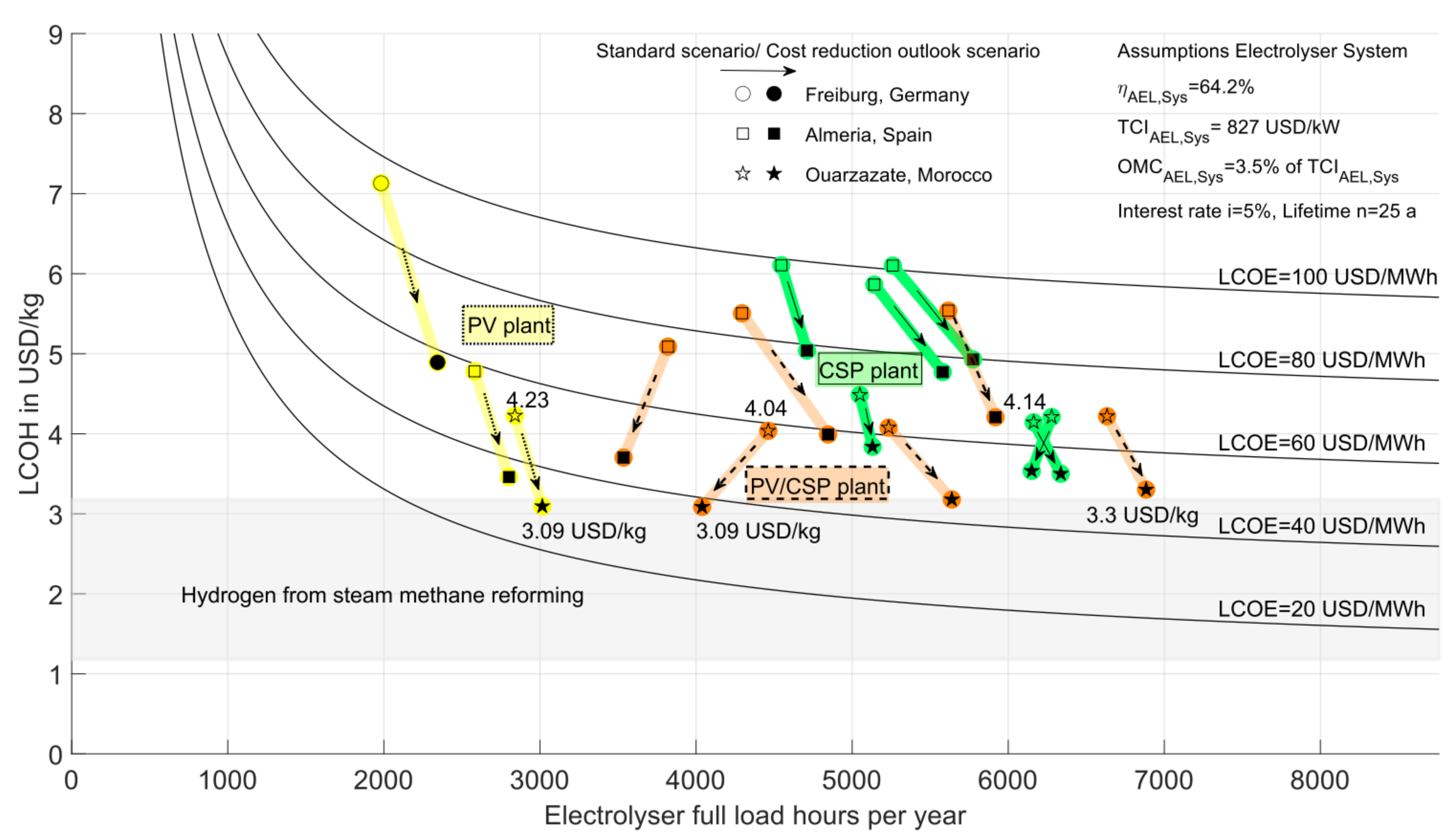

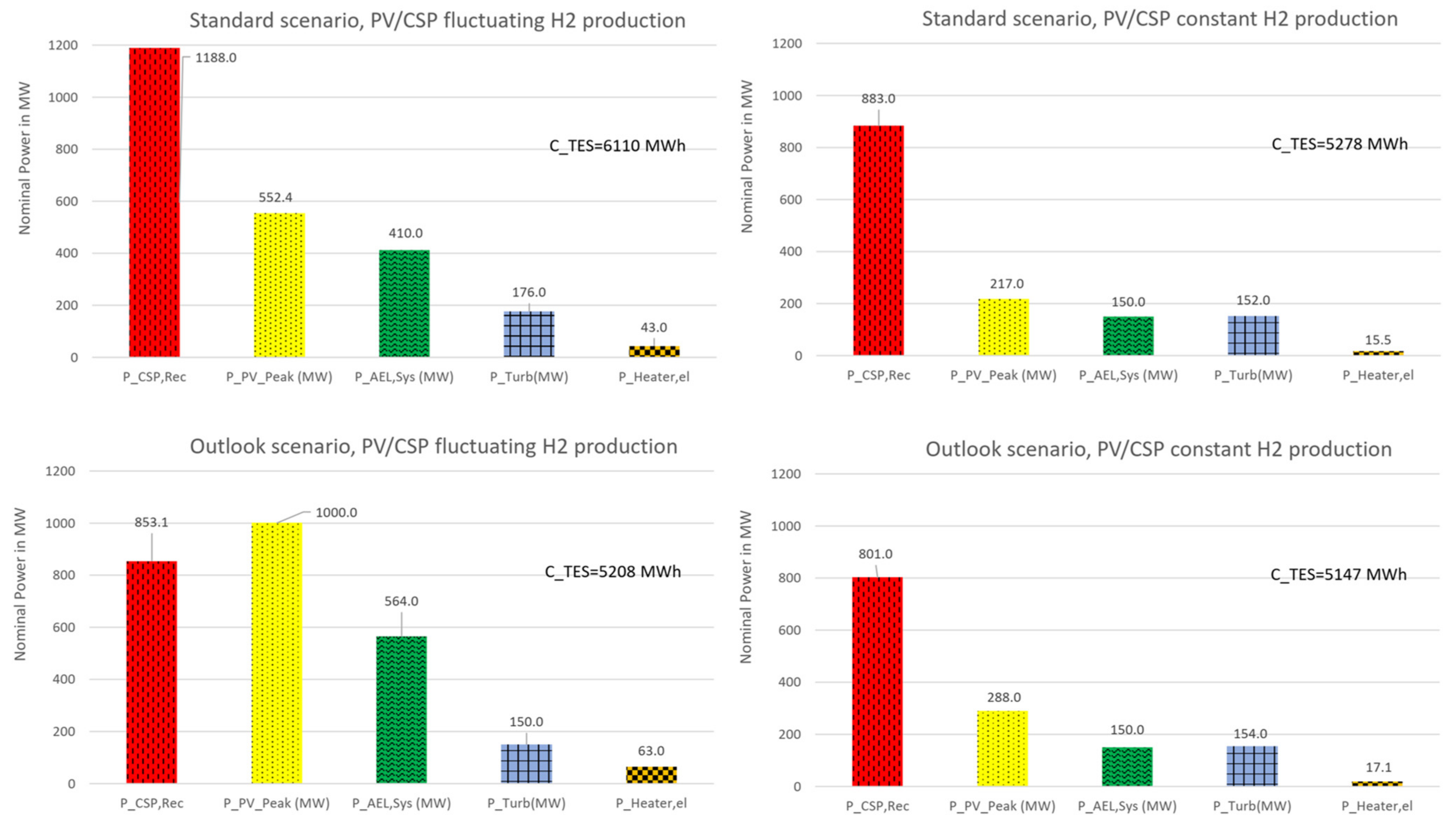
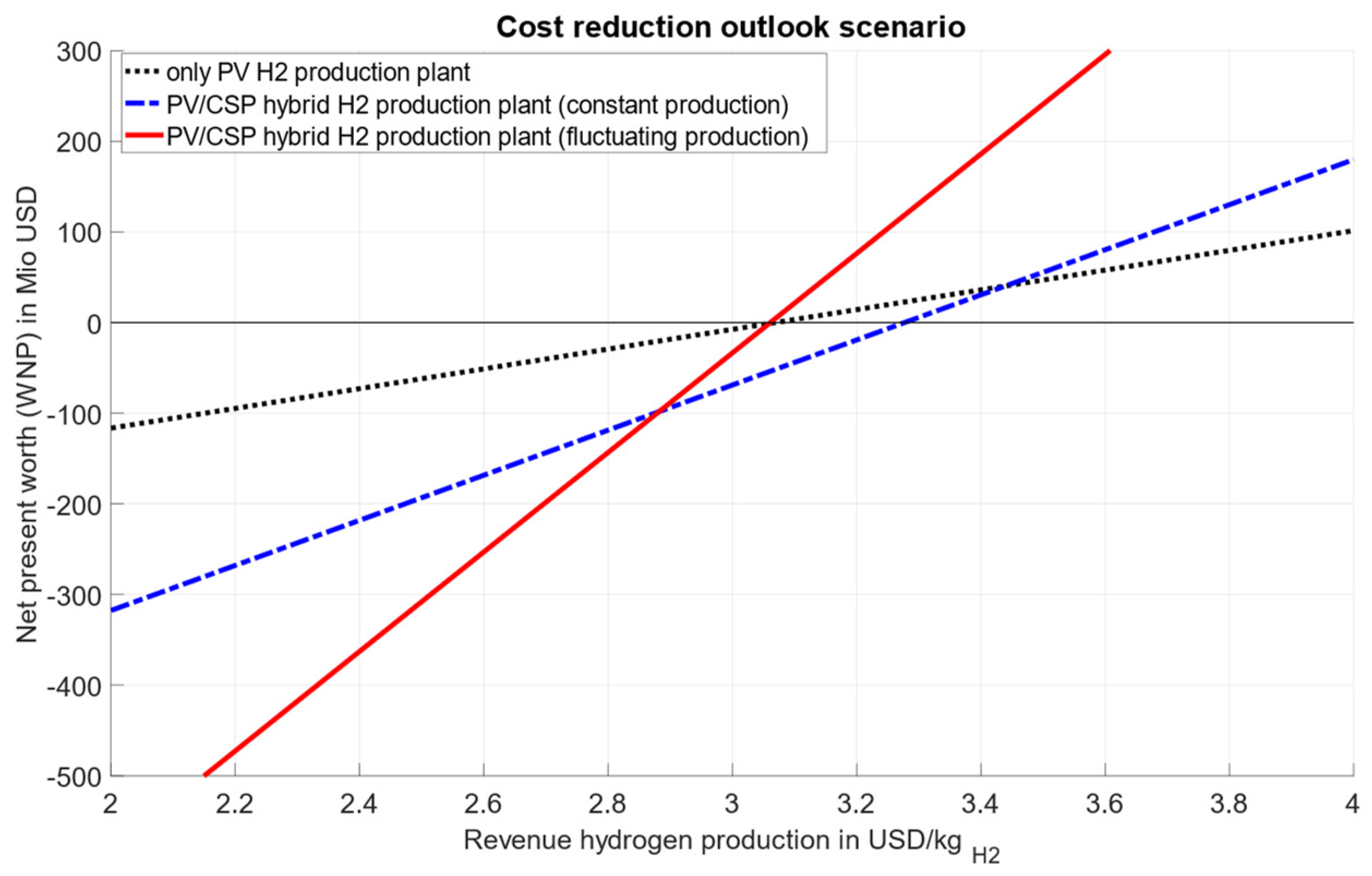
| Location | Price Index (OECD) [18,19] | Considered Technology | Solar Resource: DNI/GHI (kWh/m2a) | Source Meteo Data |
|---|---|---|---|---|
| Freiburg, Germany | 100 | PV | 971/1137 | greenius |
| Almeria, Spain | 84 | PV, CSP | 1918/1812 | greenius |
| Ouarzazate, Morocco | 42 | PV, CSP | 2518/2123 | Meteonorm 6.1 |
| Nr. | Optimization Variable | Description | Global Optimization Variable Constraints |
|---|---|---|---|
| 1 | PCSP,Rec | CSP molten salt receiver nominal input power (at DNI 900 W/m2) | 0 or: 800 1200 MW |
| 2 | PPV,Peak | PV peak power (at GHI 1000 W/m2) | 1000 MW |
| 3 | PAEL | Nominal power of alkaline electrolyser system | 1000 MW |
| 4 | PTurb | Nominal power of steam cycle turbine | 0 or: 50 MW |
| 5 | CTES | Capacity of molten salt thermal energy storage | 8000 MWh |
| 6 | PHeater,el | Nominal power of electric molten salt heater | 1000 MW |
| Parameter | Value Source [6,10] |
|---|---|
| AEL System efficiency in % | 64.2 |
| LHVH2 (kWh/kg) | 33.326 |
| AEL operational range in % | 20–100 |
| AEL standby consumption in % of nominal power | 1 |
| Hydrogen outlet pressure (bar) | 20 |
| Case | Condition | Correlation |
|---|---|---|
| CSP standby mode aux. consumption (no solar input) | ||
| CSP operating aux. consumption | ||
| Steam cycle auxiliary consumption |
| Reference year | 2018 |
| USD/Euro exchange rate | 1.1815 |
| Internal interest rate | 5% |
| Plant lifetime n (years) | 25 |
| Equipment | Parameter | Standard Scenario | Outlook Scenario | Cost Reduction |
|---|---|---|---|---|
| AEL plant | TIC (USD/kW) | 827 | 827 | 0% |
| OMC, including stack replacement (USD/a) | 0.035 of TIC | |||
| PV plant | TIC (USD/kW) | 760 | 340 | 55.3% |
| OMC, including replacement and insurance (USD/kW a) | 14.08 | |||
| Elec. heater | TIC (USD/kW) | 180 | 180 | 0% |
| OMC elec. heater (USD/kWhth) | 11.83 | |||
| CSP Equipment | Location: Almeria, Spain Cost Index: 84 [18,19] | Location: Ouarzazate, Morocco Cost Index: 42 [18,19] | ||||
|---|---|---|---|---|---|---|
| Standard Scenario | Outlook Scenario | Cost Reduction | Standard Scenario | Outlook Scenario | Cost Reduction | |
| Heliostat field (USD/m2) | 114.76 | 83.11 | 27.6% | 87.88 | 65.27 | 25.7% |
| Tower (103 USD/m) | 78.48 | 62.78 | 20.0% | 48.24 | 38.59 | 20.0% |
| Receiver (USD/kWth) | 146.57 | 102.60 | 30.0% | 124.43 | 87.10 | 30.0% |
| Thermal storage (USD/kWh) | 24.93 | 20.68 | 17.0% | 21.09 | 17.75 | 15.8% |
| Power Block (USD/kWel) | 785.12 | 708.45 | 9.8% | 693.56 | 25.62 | 9.8% |
| CSP Equipment | Annual OMC |
|---|---|
| Heliostat field (USD/m2) | 3.00 |
| Tower (USD/m) | 1063 |
| Receiver (USD/kWth) | 2.95 |
| Thermal storage (USD/kWhth) | 0.24 |
| Power Block (USD/kWel) | 0.95 |
| Scenario/Configuration | FLH AEL (h/a) | LCOE PV (USD/MWh) | LCOE CSP (USD/MWh) | LCOE to AEL (USD/MWh) | LCOE to AEL + Cost Padd (USD/MWh) |
|---|---|---|---|---|---|
| Standard cost scenario | |||||
| Only PV | 2751 | 37.92 | - | 43.85 | 46.26 |
| Only CSP | 6163 | - | 62.87 | 62.87 | 63.90 |
| PV/CSP hybrid fluctuating | 4463 | 37.92 | 69.03 | 55.07 | 55.67 |
| PV/CSP hybrid constant | 6633 | 37.92 | 77.69 | 65.84 | 66.26 |
| Outlook scenario | |||||
| Only PV | 2973 | 19.83 | - | 24.87 | 27.09 |
| Only CSP | 6337 | - | 51.02 | 51.02 | 51.94 |
| PV/CSP hybrid fluctuating | 4039 | 19.83 | 58.69 | 34.48 | 35.07 |
| PV/CSP hybrid constant | 6884 | 19.83 | 65.02 | 48.75 | 49.10 |
Publisher’s Note: MDPI stays neutral with regard to jurisdictional claims in published maps and institutional affiliations. |
© 2021 by the authors. Licensee MDPI, Basel, Switzerland. This article is an open access article distributed under the terms and conditions of the Creative Commons Attribution (CC BY) license (https://creativecommons.org/licenses/by/4.0/).
Share and Cite
Rosenstiel, A.; Monnerie, N.; Dersch, J.; Roeb, M.; Pitz-Paal, R.; Sattler, C. Electrochemical Hydrogen Production Powered by PV/CSP Hybrid Power Plants: A Modelling Approach for Cost Optimal System Design. Energies 2021, 14, 3437. https://doi.org/10.3390/en14123437
Rosenstiel A, Monnerie N, Dersch J, Roeb M, Pitz-Paal R, Sattler C. Electrochemical Hydrogen Production Powered by PV/CSP Hybrid Power Plants: A Modelling Approach for Cost Optimal System Design. Energies. 2021; 14(12):3437. https://doi.org/10.3390/en14123437
Chicago/Turabian StyleRosenstiel, Andreas, Nathalie Monnerie, Jürgen Dersch, Martin Roeb, Robert Pitz-Paal, and Christian Sattler. 2021. "Electrochemical Hydrogen Production Powered by PV/CSP Hybrid Power Plants: A Modelling Approach for Cost Optimal System Design" Energies 14, no. 12: 3437. https://doi.org/10.3390/en14123437
APA StyleRosenstiel, A., Monnerie, N., Dersch, J., Roeb, M., Pitz-Paal, R., & Sattler, C. (2021). Electrochemical Hydrogen Production Powered by PV/CSP Hybrid Power Plants: A Modelling Approach for Cost Optimal System Design. Energies, 14(12), 3437. https://doi.org/10.3390/en14123437






